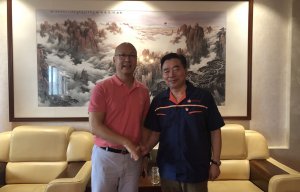
Largest-ever order for Oerlikon Neumag
The compact Staple FORCE S 1000 has been specifically designed for the economic production of staple fibres in small batch sizes of up to 15 tons per day.

20th November 2015
Innovation in Textiles
|
Neumünster/Milan
Oerlikon Neumag has exhibited an extensive plant portfolio for the production of synthetic staple fibres at ITMA 2015 that concluded in Milan this week.
Oerlikon Manmade Fibres is offering one-step or two-step technology, for polypropylene, polyester, recycled polyester, polyamide and more, for commodity or special applications.
The compact Staple FORCE S 1000 has been specifically designed for the economic production of staple fibres in small batch sizes of up to 15 tons per day. The plant impresses with its low initial investment and its compact construction.

By replacing the conventional steam and water baths with a dry drawing process over godets, the energy costs are also said to be considerably reduced.
The inline technology includes the spinning operation and the subsequent drawing in one process step. With this compact construction it is possible to produce staple fibre capacities of up to 80 tons per day. The applications are as diverse as they are specific: from fibres for geotextiles, filtration applications or hygiene applications to reinforcement fibres through to fibres for automotive applications.
Because of the extruder spinning, the inline process is well suited to processing recycled polyester. Whether as regranulated chips or directly as rPET flakes (bottle flakes), even recycled polyester that does not 100% satisfy the qualities of virgin polyester can be processed, according to the manufacturer.
A major competitive advantage of the 300 tons per day staple fibre plant for commodity fibres from Oerlikon Neumag is the considerably higher profitability per ton compared to smaller plants, which relies heavily on the energy efficiency of the new large-scale plant.

Oerlikon Neumag technology is said to offer a further advantage with the possibility of colouring fibres directly in the spinning process. Because the large plants are always connected to a polycondensation plant, fibres cannot be coloured until processing. With side stream extrusion, however, the master batch can be mixed directly into the spinning process. This means, for example, that black fibres can be produced directly. Later colouring is no longer necessary.
It is not only commodity fibres that are produced in the two-step process but bicomponent fibres, too. The company offers solutions for self-crimping fibres, binding fibres, super microfibres and hollow fibres, for example.

Business intelligence for the fibre, textiles and apparel industries: technologies, innovations, markets, investments, trade policy, sourcing, strategy...
Find out more